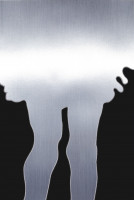
Details
Artist
Styles
Color Screenprint - Signed, dated and Numbered // Peter Halley's Exploding Cell (Gray Plume) is a screen-print from 1994, showcasing his characteristic geometric abstraction. The print features an expansive, pale gray background interrupted by circular, plume-like forms that radiate outwards. Below, a contrasting deep brown block with small, scattered speckles and linear formations suggests an architectural or structural element. Halley's work often explores themes of confinement and isolation, with his signature use of geometric shapes representing cells or prisons. The composition reflects the artist's ongoing interest in social and architectural constructs, blending minimalism with a commentary on the constraints of modern life.
Exploding Cell (Gray Plume), 1994
form
Medium
Size
92.7 x 119.9 cm
- Inches
- Centimeters
Edition
Price
Details
Artist
Styles
Color Screenprint - Signed, dated and Numbered // Peter Halley's Exploding Cell (Gray Plume) is a screen-print from 1994, showcasing his characteristic geometric abstraction. The print features an expansive, pale gray background interrupted by circular, plume-like forms that radiate outwards. Below, a contrasting deep brown block with small, scattered speckles and linear formations suggests an architectural or structural element. Halley's work often explores themes of confinement and isolation, with his signature use of geometric shapes representing cells or prisons. The composition reflects the artist's ongoing interest in social and architectural constructs, blending minimalism with a commentary on the constraints of modern life.
- Recently Added
- Price (low-high )
- Price (high-low )
- Year (low-high )
- Year (high-low )
What is minimalism?
Minimalism is a style in music and visual arts characterized by pared-down designs and simplicity. It began in Western art after World War II, gaining prominence particularly in American visual arts. Minimalism draws heavily on aspects of modernism and is often viewed as a reaction against Abstract Expressionism, as well as a precursor to post-minimal art practices. Prominent minimalist artists include Agnes Martin, Donald Judd, Robert Morris, Frank Stella, and Dan Flavin.














